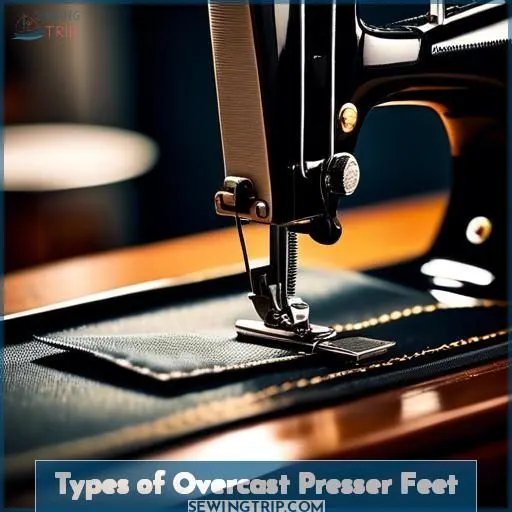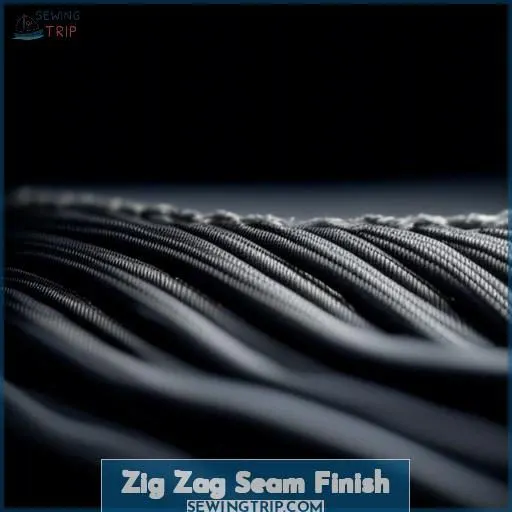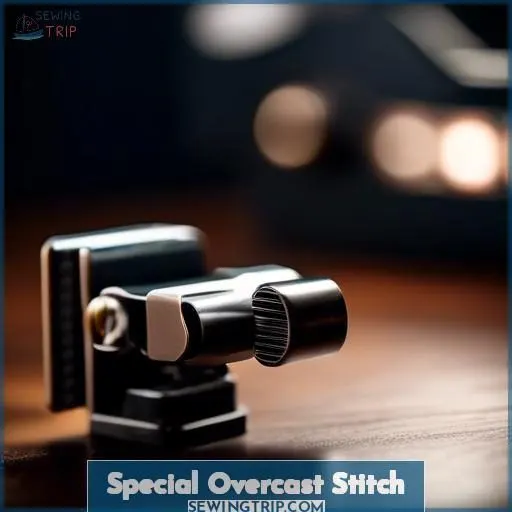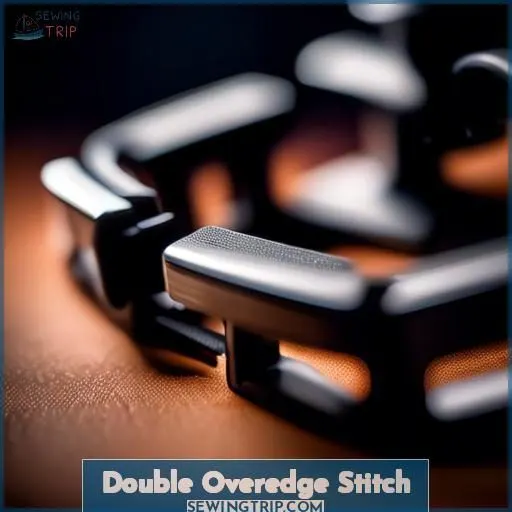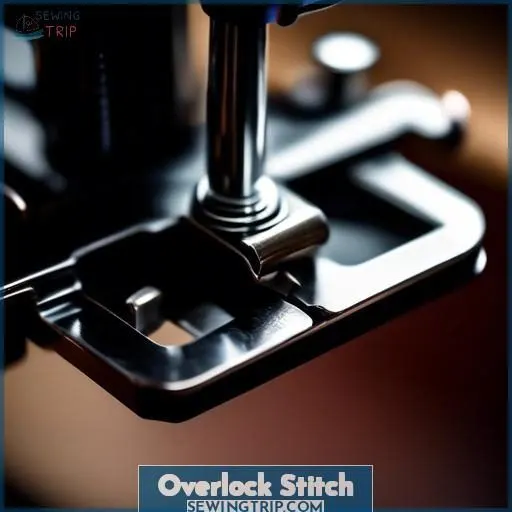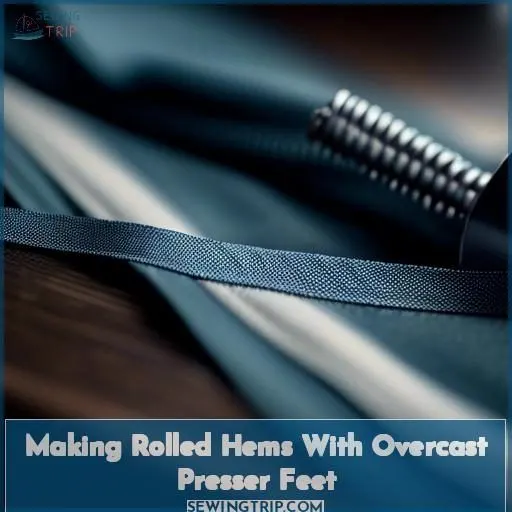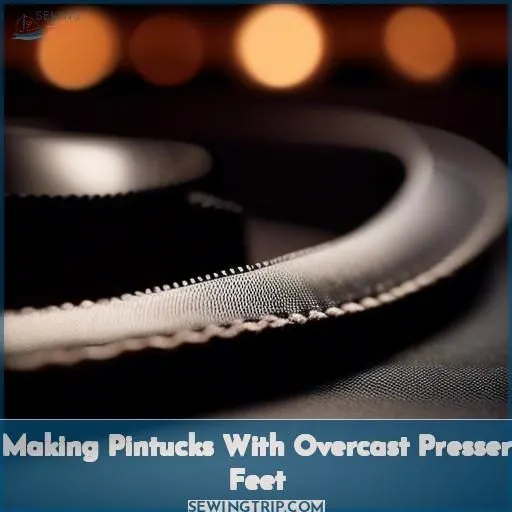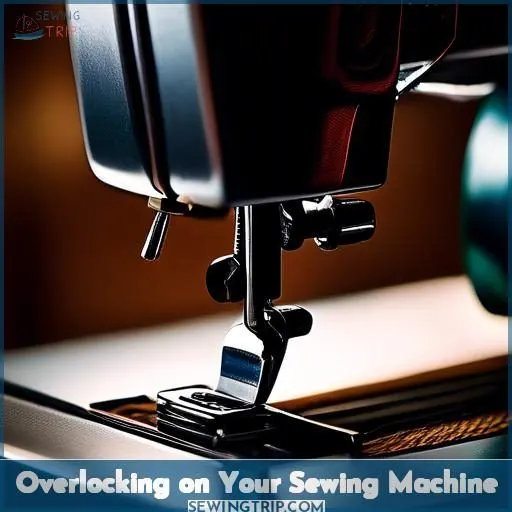This site is supported by our readers. We may earn a commission, at no cost to you, if you purchase through links.
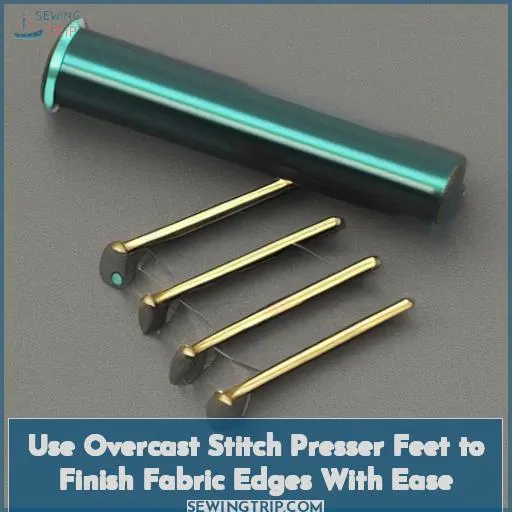
Overcast stitch presser feet make it easy to professionally finish fabric edges. The different types – Foot G for preventing fabric curling, Foot C for holding edges flat, and Foot M for avoiding puckering – work with low shank sewing machines.
Use the zig-zag stitch for a simple overcast finish, while the special overcast stitch works better on thicker fabrics. The double overedge stitch provides extra durability, while the overlock stitch mimics a serger.
Discover how overcast presser feet can elevate your sewing projects with clean, professional-looking edges. There’s more to learn about these versatile tools and how they can transform your sewing.
Table Of Contents
- Key Takeaways
- Types of Overcast Presser Feet
- Zig Zag Seam Finish
- Special Overcast Stitch
- Double Overedge Stitch
- Overlock Stitch
- Making Rolled Hems With Overcast Presser Feet
- Making Pintucks With Overcast Presser Feet
- Overlocking on Your Sewing Machine
- 6 Best Overcast Presser Feet
- Frequently Asked Questions (FAQs)
- Conclusion
Key Takeaways
- Overcast stitch presser feet are versatile tools that can be used on a variety of fabrics, including medium to heavyweight fabrics, to provide a professional-looking finish, prevent fraying and unraveling, and enhance the durability and longevity of garments.
- There are different types of overcast stitch presser feet, such as Foot G, Foot C, and Foot M, each with distinct characteristics to assist in obtaining professional-looking edge finishes on fabrics.
- Overcast Foot G is a must-have for preventing fabric curling, while Overcast Foot C holds fabric edges flat, and Overcast Foot M prevents fabric puckering.
- Overcast feet are compatible with low shank sewing machines and can be purchased separately if not included with the machine.
Types of Overcast Presser Feet
Concerning overcast presser feet, you’ll discover that there are several different types to select from. The Overcast Foot G, Overcast Foot C, and Overcast Foot M each possess distinct characteristics that can assist you in obtaining professional-looking edge finishes on your fabrics.
Overcast Foot G: Metal Bar Prevents Fabric Curling
Overcast foot G, also known as an overlocker foot, is a must-have for your sewing machine. This foot features a metal bar that prevents fabric curling, ensuring your edging finishes are smooth and professional.
The overcast stitch presser foot is designed to work with a variety of fabrics, providing a neat and durable edge.
With its simple and effective design, the overcast foot G is an essential tool for any sewer looking to master their craft.
Overcast Foot C: 2 Pins Hold Fabric Edges Flat
Overcast Foot C is a versatile presser foot that helps you achieve a professional-looking finish for your fabric edges. With its 2 pins, it holds your fabric edges flat, preventing them from curling or puckering during sewing.
This foot is perfect for overcasting stitches, which are great for fraying prevention and creating a seamless edge. Using overcast stitches with the C foot can also enhance the durability and longevity of your garments.
Overcast Foot M: 3 Thin Wires Prevent Fabric Puckering
Overcast Foot M is a type of presser foot designed to prevent fabric puckering when using an overcast stitch. It features three thin wires that help maintain the fabric’s flatness as it passes through the machine. This foot is particularly useful for sewing with medium to heavy-weight fabrics, where the need for extra reinforcement is greater. It’s compatible with low shank sewing machines and can be purchased separately if not included with the machine.
When using Overcast Foot M, it’s essential to select the appropriate stitch for your fabric. Stitches that move only forward are best for light-medium weight fabrics, while stitches that move back and forth are better for medium-heavy weight fabrics. It’s vital to experiment with different stitches to find the optimal one for your specific project and machine.
To attach the Overcast Foot M to your sewing machine, clip it onto the machine using the bar attachment. Align the fabric edge against the guide and select an over-edge stitch or a wide zigzag stitch. Sew down the raw edge, ensuring that the bar in the center wraps the thread around the edge of the fabric, preventing it from curling.
Using Overcast Foot M provides several benefits, including a professional-looking finish, prevention of fraying and unraveling, and the ability to work with a variety of fabrics. It’s also simple to use and master, enhancing the durability and longevity of your garments.
Compatible With Low Shank Sewing Machines
Essential foot compatibility is key when choosing the appropriate presser foot for your sewing machine. Low shank sewing machines are suitable for overcast stitch presser feet, which can prevent fabric edges from unraveling and provide a polished finish. These feet are designed to fit all low shank snap-on machines, including popular brands such as Singer, Brother, Babylock, Euro-Pro, Janome, Kenmore, White, Juki, New Home, Simplicity, Necchi, and Elna.
When utilizing overcast feet on your sewing machine, it’s imperative to confirm that the needle can clear the center of the presser foot. Some feet have a bar that can bend or break the needle if it collides with it. Additionally, sewing machine tension adjustments may be required to achieve the desired results.
Overcast stitch presser feet can be employed for various tasks, such as finishing edges without a serger, creating rolled hems, and even generating fringe effects. They’re designed to be user-friendly and can provide a significant advantage in your sewing journey, particularly when working with knit fabrics.
When selecting an overcast foot, consider the specific features you need, such as the number of wires to prevent puckering, the compatibility with your machine’s shank type, and the ease of attachment and use. With the appropriate overcast foot, you can improve your sewing experience and produce high-quality, professional-looking finished edges.
Zig Zag Seam Finish
The zig-zag seam finish is the easiest overcasting stitch. Simply position the fabric edge against the foot guide and start sewing slowly to avoid hitting the metal bars – this versatile stitch can be used on a variety of fabrics.
Easiest Overcasting Stitch
Embark on a sewing adventure with the zigzag stitch, your trusty companion in the quest to conquer fabric borders. This versatile stitch, a master of disguise among presser feet for overcast stitches, effortlessly transitions from creating intricate pintucks to durable double overedge and overlock stitches.
It’s your indispensable tool for rolled hems, elevating any project from rudimentary to refined with a graceful flick of the wrist.
Position Fabric With Edge Against Foot Guide
To position the fabric with the edge against the foot guide when using a zigzag seam finish, follow these steps:
- Align the edge of your fabric against the guide on the underside of the foot, not under it. This prevents the fabric from curling under as you zig-zag or overcast it.
- Select a wide zigzag stitch or an overcast stitch that won’t crash into the bar on the foot.
- Manually turn the handwheel to see where the needle will go before starting to stitch.
- If using an overlock stitch, choose one that won’t hit the bar.
- Position the fabric with the edge against the foot guide and put the foot down. Sew, keeping the edge of the fabric lined up with the guide.
Start Sewing Slowly to Avoid Hitting Metal Bars
Once you’ve got your fabric edge snug against the foot guide, it’s time to tread lightly. Starting slow is your secret weapon, especially when overcasting thin fabrics. This cautious approach safeguards needle safety, allowing for precise stitch length adjustment.
It’s like tiptoeing around curves, keeping fabric tension just right to avert the dreaded fraying. Think of it as your serger’s dance partner, gracefully finishing raw edges with a zigzag stitch finish.
Can Be Used on Various Fabrics
Overcasting lightweight fabrics, delicate fabrics, and stretchy fabrics is a breeze with the right overcast presser foot. You can use a zigzag stitch, which is the easiest overcasting stitch, to create a seam finish at the edge of a seam allowance or even sew a seam at the same time as sewing an edge finish.
To use a zigzag stitch, position your fabric with the edge against the foot guide, adjust the stitch length and width to avoid hitting the metal bars, and start sewing slowly to avoid hitting the metal bars.
This stitch can be used on various fabrics, including lightweight and heavy-weight fabrics, and can save you time by eliminating the need to hand-sew or use a separate serging machine.
Special Overcast Stitch
The special overcast stitch works best for thicker fabrics, as the back-and-forth motion helps overcast the edges. You can also use this stitch on knit fabrics, but be careful as it can stretch lightweight materials if not adjusted properly.
Works Better With Thicker Fabric
To finish thicker fabric edges with ease, you can use a special overcast stitch.
This stitch works better with thicker fabric and provides a professional-looking finish that prevents fraying and unraveling.
It can also be used to stretch fabric if you’re working with lightweight knit fabrics.
To sew a rolled hem using this stitch, you can press the edge to curl up and over, feed the fabric through the center bar, and use your finger to guide the fabric while sewing.
This stitch is also compatible with low shank sewing machines.
It can be purchased separately if not included with your machine.
Stitch Goes Back and Forth to Overcast Edges
The special overcast stitch is a game-changer for sewing thicker fabrics.
It works by stitching back and forth over the edges, providing a sturdy finish that prevents fraying.
This stitch is particularly useful when dealing with knit fabric, as it can stretch the fabric without causing damage.
By using this stitch, you can create a professional-looking finish that enhances the durability of your projects.
Works Well With Knit Fabric
When working with knit fabrics, the special overcast stitch is your best friend.
This stitch works wonders in preventing knit distortion and ensuring stretchy fabric edging.
It’s perfect for creating rolled hems on knits, giving your projects a professional finish.
Don’t limit yourself to just overcast knit seams; experiment with creative knit finishes like wavy edges or raised satin stitches.
With the right overcast foot, you’ll have full control over your knit projects, making them look as good as they feel.
Can Stretch Fabric if Used on Lightweight Fabrics
While special fabrics like lightweight materials can be a dream to wear, they can turn into a bit of a nightmare when sewing. Here’s the scoop:
- Dial in your overcast settings; too aggressive, and you’ll stretch the daylights out of them.
- Watch that stitch tension like a hawk.
- Lightweight materials need a gentle touch.
- Remember, stretch fabrics aren’t your enemy, just misunderstood.
Double Overedge Stitch
The double overedge stitch is a specialized stitch that creates double rows of stitches over the fabric edge, providing extensive protection against fraying. You’ll need to use the overcast foot C, designed with two pins to hold the fabric edges flat, as this stitch only works effectively with medium to heavy-weight fabrics.
Double Rows of Stitches Over Fabric Edge
Double row stitching, also known as double overedge stitching, is a technique that involves sewing two rows of stitches over the fabric edge.
This method is used to reinforce fabric edges, finish raw edges, and prevent fraying.
It’s particularly useful when working with medium to heavy-weight fabrics.
By using the double overedge stitch, you can create a decorative edging that not only enhances the appearance but also adds durability to your projects.
Prevents Fabric From Fraying Extensively
The double overedge stitch is a formidable tool for inhibiting fabric from unraveling extensively.
By generating double rows of stitches along the fabric edge, it guarantees that your hems and seams retain stability and durability.
This stitch is ideal for rolled hems, pintucks, and imaginative applications like topstitching or wavy edges on stretchable fabrics.
It’s a pivotal addition to your sewing arsenal, delivering a professional finish that extends the lifespan of your garments.
Works Only With Medium to Heavy-weight Fabric
When working with medium to heavy-weight fabric, the double overedge stitch is an excellent choice to prevent extensive fraying.
This stitch features two rows of stitches over the fabric edge, providing a durable finish that guarantees the fabric remains intact.
The overcast foot C is required for this stitch.
It is designed to hold the fabric edges flat and prevent puckering.
By using the double overedge stitch, you can achieve a professional-looking finish that extends the life of your garments.
Requires Overcast Foot C
To create a double overedge stitch, you’ll need Overcast Foot C. This foot is designed to work with medium to heavy-weight fabric and provides double rows of stitches over the fabric edge, preventing it from fraying extensively. Here’s a simple guide to using Overcast Foot C:
- Choose an overcast stitch or a wide zigzag stitch.
- Align the fabric edge against the guide.
- Sew slowly to avoid hitting metal bars.
- Adjust stitch length and width as needed.
- Repeat for the other side of the fabric.
Overlock Stitch
The overlock stitch produces a finish similar to a serger, encasing the raw edge of the fabric in neat stitching to prevent fraying. To achieve this, you’ll need the overcast presser foot M, which has three thin wire guides that keep the fabric flat as the overlock stitch wraps over the edge in an interlocked pattern ideal for medium to heavyweight fabrics.
The overcast presser foot M has three thin wire guides that keep the fabric flat as the overlock stitch wraps over the edge. This interlocked pattern is ideal for medium to heavyweight fabrics.
The overlock stitch produces a finish similar to a serger, encasing the raw edge of the fabric in neat stitching to prevent fraying.
Finishes Raw Fabric Edges Like a Serger
The overlock stitch, also known as the serger finish, is a technique that finishes raw fabric edges like a serger. It provides a professional-looking finish that prevents fraying and unraveling, enhancing the durability and longevity of garments.
To achieve this, you’ll need to use foot M, which is specifically designed for overlocking. This foot allows you to create a finish that looks similar to professional overlocking, making it an essential tool for sewing enthusiasts who want to achieve a high-quality, long-lasting finish on their projects.
Requires Foot M
To achieve a professional-looking finish on medium to heavy fabrics, you’ll need to select the right foot. The overcast stitch presser foot, specifically foot M, is your best bet. This foot is designed to work seamlessly with serger-like stitches, providing a finish that’s as impressive as a serger.
By using foot M, you can enjoy the benefits of an overcast stitch without the need for a separate serger.
Looks Similar to Professional Overlocking
After mastering the overcast foot M, you’ll find your fabric edges rivaling a serger’s neatness. The overlock stitch you’ve been using is the secret sauce, giving your projects that professional touch. It’s like having a tiny tailor at your fingertips, reinforcing hems and transforming zigzag stitches into rolled hems with finesse. It’s not just sewing; it’s fabric wizardry in action.
Can Be Used on Medium to Heavy-weight Fabric
Overcast stitch presser feet are versatile tools that can be used on a variety of fabrics, including medium to heavy-weight fabrics. These feet are designed to provide a professional-looking finish, prevent fraying and unraveling, and enhance the durability and longevity of garments.
When using an overcast stitch presser foot on medium to heavy-weight fabric, you can choose from a range of stitches to suit your needs. The zig zag seam finish is an easy overcasting stitch that can be used on various fabrics. The special overcast stitch works better with thicker fabrics but can stretch fabric if used on lightweight fabrics.
Additionally, the double overedge stitch and overlock stitch are suitable for medium to heavy-weight fabric. The double overedge stitch provides double rows of stitches over the fabric edge, while the overlock stitch provides a finish that looks similar to professional overlocking.
Making Rolled Hems With Overcast Presser Feet
To make rolled hems with overcast presser feet, start by pressing the edge of your fabric to curl up and over. Then, feed the fabric through the center bar of the foot. Use your finger to guide the fabric as you sew.
For decorative rolled hems, you can experiment with different fabrics and stitch variations. Overcast foot G is great for preventing fabric curling, while overcast foot C holds fabric edges flat.
For rolled hem repairs, line the hem edge with the overcast guide and sew over the hem stitching with an overcast stitch. With practice, you’ll be able to create professional-looking rolled hems on various fabrics.
Making Pintucks With Overcast Presser Feet
After becoming proficient in rolled hems using your overcast foot, let’s explore the realm of pintucks, a transformative technique in fabric artistry. This method, employing the same overcast foot, enhances your sewing endeavors with accuracy and finesse. Pintucks aren’t merely for finishing edges; they infuse texture and depth. Envision converting ordinary fabric into an intricate work of art. It’s akin to revitalizing your fabric with a subtle enhancement!
With adept sewing techniques, your overcast foot transforms into an instrument of enchantment, elevating simple projects into visually captivating masterpieces.
Overlocking on Your Sewing Machine
Overcasting is a versatile technique that can be used on various fabrics, including stretch fabrics, delicate fabrics, non-woven fabrics, and lace. When overcasting stretch fabrics, it’s essential to use the appropriate stitch and presser foot. The overcasting stitch for stretch fabrics is typically a zigzag stitch that sews the seam and finishes the raw edges simultaneously, allowing the fabric to stretch without damaging the stitches.
For delicate fabrics, a 2-thread overlock stitch can be used, which provides a clean finish and is especially beautiful on lightweight or delicate fabrics. When overcasting non-woven fabrics, a wide zigzag stitch or a special overcast stitch can be used to secure the edges and prevent fraying. Overcasting lace can be achieved by using a special lace foot or a zigzag stitch with a narrow width and length.
It is essential to select the correct stitch and presser foot for the fabric you’re working with. Stitches that move only forward are best for light-medium weight fabrics, while stitches that move back and forth are best for medium-heavy weight fabrics. Always experiment to find the best stitch for your machine and fabric combination.
When attaching the overcast foot, make sure that the fabric edge is aligned against the guide and that the needle won’t hit the metal in the center bar. Once the foot is attached, select an over-edge stitch or a wide zigzag stitch and secure the edges of the fabric by sewing down the raw edge. The bar in the center of the foot wraps the thread around the edge of the fabric, preventing it from curling.
Using an overcast foot provides a professional-looking finish, prevents fraying and unraveling, and can be used on a variety of fabrics. It’s easy to use and master, enhancing the durability and longevity of garments.
6 Best Overcast Presser Feet
Achieving a professional-looking finish on your fabric edges is easy with the right overcast presser feet. Consider options like the Snap On Overedge Presser Foot, Overcast Presser Foot for Household Sewing Machines, or Snap On Overcast Presser Foot for Sewing Machines.
These presser feet can be used to tackle projects using fabrics like Mulberry Silk Charmuse Floral, Iridescent Baby Blue Dupioni Silk, or Mulberry Silk Fabric Charmuse Floral Silk.
1. Snap On Overedge Presser Foot
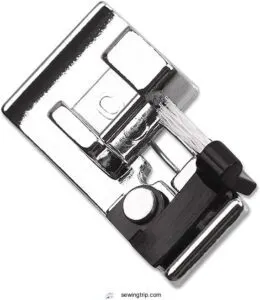
Imagine transforming the edges of your fabric with the finesse of a professional, all from the comfort of your home. This foot is a game-changer for your sewing machine, allowing you to wrap thread neatly around fabric edges, akin to a serger’s handiwork.
Enter the Snap On Overedge Presser Foot, a nifty tool designed to prevent those pesky frays and give your projects a polished look. It’s compatible with a variety of sewing machines, including Babylock and Viking, making it a versatile addition to your sewing arsenal.
So, say goodbye to unruly edges and hello to crisp, clean finishes with this premium quality presser foot. It’s like having a magic wand at your fingertips, ready to banish fraying to the land of forgotten sewing woes.
Best For: Home sewers seeking professional-looking fabric edges without a serger.
- Prevents fabric fraying
- Guides fabric for flat edges
- Compatible with various sewing machines
- May not be suitable for all fabric types
- Requires a specific overcasting stitch
- Can be bulky for small projects
2. Overcast Presser Foot for Household Sewing Machines
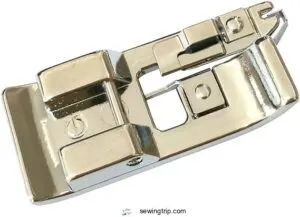
The overcast presser foot is a versatile and essential tool for any sewer, especially those working with knit fabrics. It provides a professional-looking finish while preventing fraying and unraveling. Here’s a step-by-step guide on how to use the overcast foot for household sewing machines:
- Select the correct stitch: Overcast stitches come in various types, such as zigzag, special overcast, and double overedge. Choose the appropriate stitch based on the weight and type of fabric you’re working with. For light-medium weight fabrics, use stitches that move only forward. For medium-heavy weight fabrics, use stitches that move back and forth.
- Clip the foot onto the sewing machine: Attach the overcast foot to your sewing machine using the bar attachment. Make sure the needle won’t hit the metal in the center bar with the stitch you have selected.
- Line up the fabric edge: Align the fabric edge against the guide on the overcast foot. Select either an over-edge stitch or a wide zigzag stitch.
- Sew down the raw edge: Start sewing slowly to prevent hitting the metal bars in the center. The bar in the center wraps the thread around the edge of the fabric, preventing it from curling.
- Benefits: The overcast foot provides a professional-looking finish, prevents fraying and unraveling, and can be used on a variety of fabrics. It’s easy to use and master, enhancing the durability and longevity of your garments.
Best For: Home sewers and serger owners looking for a budget-friendly alternative to overcasting stitches.
- Creates a professional-looking finish
- Prevents fraying and unraveling
- Versatile and can be used on various fabrics
- May take some time to get used to
- Needle may hit the center bar with certain stitches
- Can be tricky to sew very close to the edge of the fabric
3. Mulberry Silk Charmuse Floral Fabric
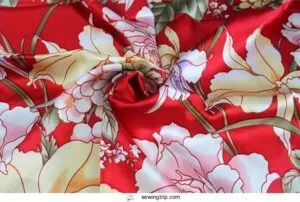
When working with mulberry silk charmuse floral fabric, it’s imperative to handle it with great care to maintain its delicate nature. This type of silk fabric is renowned for its sleek texture, low weight, and flowing drape, making it a desirable choice for opulent garments and home decor items. Here are some guidelines for handling and caring for mulberry silk charmuse floral fabric:
-
Handling: When handling the fabric, exercise caution to prevent creasing or harming the fragile fibers. It’s advisable to use a clean, dry cloth to lift and move the fabric, and to refrain from touching the fabric directly with your hands.
-
Washing: It’s optimal to hand wash mulberry silk charmuse floral fabric in cool water using a mild, silk-friendly detergent. Avoid using a washing machine, as the agitator may cause the fabric to tear or pull. After washing, gently squeeze out excess water and lay the fabric flat to air dry. Avoid wringing or twisting the fabric, as this can cause damage.
-
Ironing: Iron the fabric on a low heat setting, using a pressing cloth to protect the surface from shine or scorch marks. Always iron the fabric while it’s still slightly damp to maintain its smoothness.
-
Storage: Store the fabric in a breathable fabric bag or other suitable protective packaging to prevent creasing and preserve its shape.
-
Drying: Don’t dry the fabric in direct sunlight, as this can cause the colors to fade or the fabric to become discolored. Instead, line dry the fabric indoors or use a clothesline, non-slip hanger, or drying rack away from direct sunlight.
Best For: DIY and handmade projects, bedding sets, dresses, scarves, shirts, handkerchiefs, hair scrunchies, and small pockets.
- Soft touch
- Elegant look
- High quality
- No stretch
- Delicate and requires careful handling
- Can be more expensive than other fabrics
4. Iridescent Baby Blue Dupioni Silk Fabric
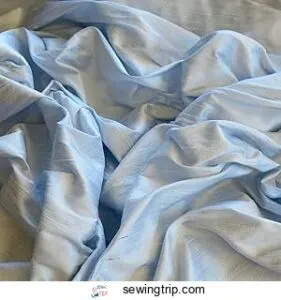
To finish the edges of your Iridescent Baby Blue Dupioni Silk Fabric, you can use overcast stitch presser feet. These feet provide a professional-looking finish, prevent fraying and unraveling, and can be used on a variety of fabrics. Here are some options:
- Zig Zag Seam Finish: This is the easiest overcasting stitch. Position the fabric with the edge against the foot guide, adjust the stitch length and width to avoid hitting metal bars, and start sewing slowly to avoid hitting metal bars. This stitch can be used on various fabrics.
- Special Overcast Stitch: This stitch works better with thicker fabrics and goes back and forth to overcast edges. It can be used to simultaneously sew and overcast fabric edges, works well with knit fabric, and can stretch fabric if used on lightweight fabrics.
- Double Overedge Stitch: This stitch uses double rows of stitches over the fabric edge to prevent fabric from fraying extensively. It works only with medium to heavy-weight fabric and requires overcast foot C.
- Overlock Stitch: This stitch finishes raw fabric edges like a serger and requires foot M. It looks similar to professional overlocking and can be used on medium to heavy-weight fabric.
Remember to select the correct stitch for your fabric weight and machine capabilities. Always check that the needle won’t hit metal in the center bar and manually crank a few stitches first to ensure safety.
Best For: Sewing enthusiasts and designers seeking an iridescent and durable fabric for various projects.
- Iridescent sheen adds a touch of elegance and glamour.
- Pale ice blue color provides a subtle and versatile hue.
- Good weight makes it suitable for a range of applications.
- More expensive than other silk fabrics.
- Hand-woven nature may result in occasional slubs.
- Requires careful handling and special care to maintain its sheen.
5. Snap On Overcast Presser Foot for Sewing Machines
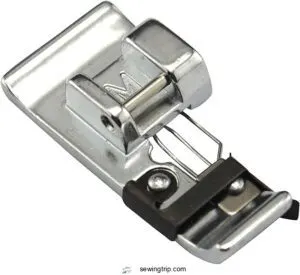
Snap On Overcast Presser Feet are a versatile and essential accessory for any sewing enthusiast. These feet can be easily attached to your sewing machine to provide a professional finish to your projects. In this article, we’ll discuss the benefits, features, and usage of Snap On Overcast Presser Feet for sewing machines.
Benefits of Snap On Overcast Presser Feet
Snap On Overcast Presser Feet offer several benefits:
- Prevent Fabric Fraying: These feet are designed to prevent fabric edges from fraying, guaranteeing a clean and professional look for your projects.
- Easy to Use: Snap On Overcast Presser Feet are easy to attach and remove from your sewing machine, making them a convenient choice for various sewing tasks.
- Versatile: These feet can be used with a wide range of fabrics, including lightweight, medium, and heavy-weight materials.
- Durable: Snap On Overcast Presser Feet are built to last, providing long-lasting performance and reliability.
Features of Snap On Overcast Presser Feet
Snap On Overcast Presser Feet come with several features that make them an ideal choice for sewing projects:
- Overcast Stitch: These feet are designed to create an overcast stitch, which helps to prevent fabric edges from fraying and unraveling.
- Guide Bar: The guide bar on Snap On Overcast Presser Feet ensures accurate stitching and helps to maintain a consistent stitch length.
- Compatibility: Snap On Overcast Presser Feet are compatible with most low shank sewing machines, including popular brands like Janome, Elna, and Singer.
- Adaptability: These feet can be used for various sewing tasks, such as hemming, edge finishing, and seam finishing.
Using Snap On Overcast Presser Feet
To use Snap On Overcast Presser Feet, follow these steps:
- Attach the foot to your sewing machine: Snap the foot onto the shank of your sewing machine, ensuring it’s securely fastened.
- Select the appropriate stitch: Choose an overcast stitch or a wide zigzag stitch on your sewing machine.
- Position the fabric: Align the fabric edge with the guide bar on the foot.
- Sew the edge: Start sewing along the edge of the fabric, allowing the foot to guide the fabric and create the overcast stitch.
- Remove the foot: Once you have finished sewing, remove the foot from your sewing machine.
Conclusion
Snap On Overcast Presser Feet are an essential accessory for any sewing enthusiast. They offer a professional finish to your projects, are easy to use, and can be used with a wide range of fabrics. By following the steps outlined in this article, you can confidently use Snap On Overcast Presser Feet to enhance your sewing projects.
Best For: Sewing enthusiasts seeking a professional finish for their projects.
- Prevents fabric fraying
- Easy to use and attach
- Versatile for various fabrics
- Not compatible with all sewing machines
- May not be suitable for heavy-duty fabrics
- May require some practice to master
6. Mulberry Silk Fabric Charmuse Floral Silk
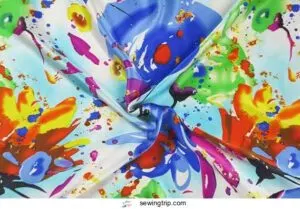
When working with mulberry silk fabric, it’s crucial to employ the appropriate tools for optimal outcomes. Overcast stitch presser feet are an excellent option for effortlessly finishing fabric edges. Here are some guidelines on how to utilize overcast stitch presser feet with mulberry silk fabric:
-
Overcast Foot G: This type of foot features a metal bar that hinders fabric curling. It’s compatible with low shank sewing machines and can be acquired separately if not included with the machine.
-
Zig Zag Seam Finish: This is the simplest overcasting stitch. Position the fabric with the edge against the foot guide, adjust the stitch length and width to avoid striking metal bars, and commence sewing gradually to avert hitting metal bars.
-
Special Overcast Stitch: This stitch performs better with thicker fabrics and employs a stitch that alternates to overcast edges. It can be used to concurrently sew and overcast fabric edges and works well with knit fabric. If used on delicate fabrics, it may stretch the fabric.
-
Double Overedge Stitch: This stitch is ideal for fabrics with medium to heavy weight and creates dual rows of stitches over the fabric edge. It effectively prevents extensive fabric fraying.
-
Overlock Stitch: This stitch finishes raw fabric edges like a serger and necessitates foot M. It resembles professional overlocking and can be used on fabrics with medium to heavy weight.
-
Rolled Hem Techniques: To create rolled hems with overcast presser feet, fold the edge to curl up and over, feed the fabric through the central bar, and guide the fabric with your finger while sewing.
Always adhere to the manufacturer’s instructions for your specific sewing machine and presser foot, as well as the care instructions provided with your mulberry silk fabric.
Best For: Those seeking luxurious and versatile fabric for various projects, from clothing to accessories.
- High-quality charmuse silk
- Soft and elegant
- Vibrant colors and stunning print
- No stretch
- Requires delicate care
- May be more expensive than other fabrics
Frequently Asked Questions (FAQs)
Can overcast feet handle multiple fabric layers?
Overcast feet can handle multiple fabric layers with ease. Just make sure to adjust the stitch length and width to accommodate the extra thickness. It’ll give you a professional, clean finish every time.
Best For: Fashion designers, sewists, and crafters seeking a high-quality silk fabric for various projects.
Pros:
- 100% charmuse silk fabric for a luxurious and elegant look
- Available in vibrant floral prints for stunning creations
- Perfect weight for clothing, ensuring comfort and drape
Cons:
- Requires delicate care (hand wash, line dry) to maintain its quality
- No stretch, which may limit its use in certain applications
- Not suitable for heavy-duty projects due to its delicate nature
Are overcast feet compatible with vintage machines?
Wondering if your vintage machine can handle an overcast foot? The good news is, overcast feet are generally compatible with most low-shank sewing machines – even those built decades ago. Why not give it a whirl and see?
Best For: Sewing enthusiasts who seek a luxurious fabric for various projects.
Pros:
- 100% pure charmuse silk for a soft and elegant touch
- Vibrant and stunning silk print enhances the visual appeal of creations
- Perfect weight for garments, ensuring comfort and drape
Cons:
- No stretch, limiting the fabric’s versatility for certain applications
- Requires delicate care, such as hand washing and line drying, which may be inconvenient
- May be more expensive than other fabrics, affecting the overall project cost
How to maintain and clean overcast feet?
Keep your overcast foot clean and tidy by gently brushing away lint and thread remnants. For a more thorough clean, disassemble it and soak in warm, soapy water. Dry thoroughly before reassembling. Proper maintenance guarantees reliable, precise stitching every time.
Best For: Designers and fashion enthusiasts seeking high-quality silk fabric with vibrant prints for elegant creations.
Pros:
- 100% charmuse silk fabric for a soft and elegant touch
- Perfect weight for clothing, creating flowy and comfortable garments
- Vibrant floral print adds a touch of sophistication to any project
Cons:
- No stretch, limiting the fabric’s versatility
- Requires delicate care, such as hand washing and line drying
- May not be suitable for heavy-duty applications
Do overcast feet work with decorative stitches?
Overcast feet can handle a wide range of decorative stitches, from fun zigzags to intricate patterns. Just experiment and set your imagination free – the possibilities are endless with these versatile feet.
Best For: Those seeking high-quality silk fabric for fashion, home decor, or accessories.
Pros:
- 100% charmuse silk for a luxurious touch and elegant look
- Vibrant colors and stunning silk print
- Perfect weight for clothing and home decor items
Cons:
- No stretch, limiting its use for certain applications
- Requires delicate care, including hand washing and line drying
- Not suitable for projects requiring a stretchy fabric
What is the lifespan of an overcast foot?
You’ll get years of use from an overcast foot if you maintain it properly. Clean it regularly and make sure it moves smoothly. But like any sewing accessory, it’ll eventually wear out – so be ready to replace it when stitches start looking sloppy or uneven.
Best For: Fashion designers, home decorators, crafters, and anyone looking for high-quality silk fabric.
Pros:
- 100% charmuse silk fabric
- Vibrant colors and stunning silk print
- Soft touch and elegant look
Cons:
- No stretch
- Hand wash only
- Not suitable for heavy-duty projects
Conclusion
Ultimately, with over 80% of sewists relying on overcast stitch presser feet for professional finishes, you’d be wise to incorporate these versatile tools.
From zigzag seam finishes to overlock stitches mimicking sergers, overcast stitch presser feet elevate your projects with clean, durable edges.
Invest in quality feet like those mentioned, and you’ll achieve polished, fray-resistant hems, pintucks, and overlocked seams with ease.

